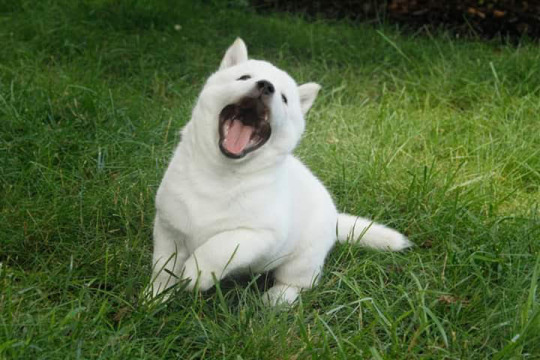#positive training

Some of you may have been wondering why the blogging hiatus. That’s because I’ve been extremely busy raising a litter of growlybiteyjumpy things, er– Hokkaido Ken puppies. Since two of them will be staying for at least another month until they can fly to their new homes, I thought I’d go ahead and share my tried and true methods for potty training.
Note: I’ll be using the term “puppy” in this post. However, this post applies to adult dogs just as easily!
The first thing you’ll need is a means of containment for your puppy. For now, start with a crate. All puppies coming from a responsible breeder or experienced foster home should have already been desensitized to being in a crate. If your puppy is coming from a shelter, pet store, or backyard breeder, I highly recommend starting with Susan Garret’s Crate Games DVD as quickly as possible. Crates should be just big enough for your puppy to curl up and lay down in. If the crate is too big, this will make potty training much harder because they will begin to designate a specific side of their crate for pottying in vs sleeping in. PUPPIES DO NOT LIKE TO POTTY WHERE THEY SLEEP! We’re going to work with this. Many crates these days come with wire dividers so you can gradually adjust the size of the crate to fit your growing puppy. If your crate does not come with such divider, using a cardboard box to divide the crate and gradually reducing the size of the box works as well! (Though you may have issues with your puppy chewing the box.)
Your puppy will need to be let out every hour during the day, and every time he starts to cry at night. Just because your puppy can “hold it” while he’s sleeping at night does not mean he can do the same during the day. When you let him out, leash him and take him directly to his potty place (typically outside, but I realize running down three flights of stairs if you live in an apartment isn’t always feasible; sod potty patches or piddle pads are also acceptable).
Leashing him does two important things:
- It builds a positive association between the leash and good things, and
- It helps him differentiate between potty time and play time
You should do minimal wandering with your puppy when you are attempting to get him to potty. Hold the end of a six foot leash. If necessary, you may take one or two steps in any direction, but no more than that. Give him five minutes to do his thing. Once he does, and wait for him to finish so you don’t cause him to STOP going, shower him with praise/treats while saying “Good GO POTTY!” Only after he potties should you unclip his leash (if he’s indoors or in a securely fenced in location) and let him sniff around or play for thirty minutes before putting him back in his crate.
This teaches him two things:
- “Go potty” is something he can do on cue, and
- The faster he goes potty, the faster play time comes
It’s extremely important to be consistent about your praise and your cues. If you start slacking off, the inconsistency will show.
When your puppy starts getting the hang of this, introduce an x-pen to give him more freedom. Place his crate inside the x-pen, along with the potty patch or piddle pad if you are going that route. If your puppy is successfully using the potty patch, gradually give him more freedom and start moving the potty patch closer to the door until your puppy will go to the door when he needs to potty.
Keep in mind that a puppy doesn’t have full bladder control until 16-20 weeks of age, sometimes later! Forgive mistakes, and never correct for “happy pee” (puppies eliminating themselves when excited). Remember that potty training is a long process, and while many puppies will progress very quickly using the methods above, there may still be accidents if you aren’t careful about supervising. If your puppy does have an accident and you didn’t catch them in the act, promptly clean it up with an enzymatic cleaner and avoid punishing your puppy for it. All punishment does is confuse a puppy and it can cause issues further down the road.
Still having potty training issues? Stay tuned for my next blog post on potty training troubleshooting!
